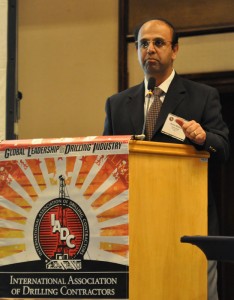Deepwater demands require upgrade in surface, downhole technologies alongside industry collaboration
By Joanne Liou, editorial coordinator
Deepwater drilling in the US Gulf of Mexico (GOM) is pushing limits with depths around 34,000 ft, more than 25,000 psi bottomhole pressure (BHP) and 250°F bottomhole temperature (BHT), and the numbers will only get higher with the next generation of deepwater rigs and equipment. Tomorrow’s rig will boast the capacity to reach 35,000- to 40,000-ft measured depth with more than 30,000-psi BHP and greater than 300°F BHT, Rohit Mathur, account manager of Baker Hughes, explained at the IADC International Deepwater Drilling Conference and Exhibition in Rio de Janeiro, on 17 April.

Presenting a service company’s approach, Mr Mathur explained the current challenges in the GOM, from hurricanes to high pressures, that are shaping expectations of the type of rigs that will be necessary and the equipment specifications that will be needed in light of formation issues and the wellbore itself. “The next-generation (derrick) will need to be rated to 2.5 to 3 million lbs, 2 million-lb traveling capacity, 2 million-lb active heave compensation, 30,000 ft or more of tubing racked back on rig floor itself and have the capability to drill at least to 40,000 ft drilling capacity on depth,” he said.
In the next five years, Mr Mathur expects deepwater rigs to have 12,000-ft storage of riser onboard and in the next 10 years, 15,000 ft. Cementing units will need 3,000 hp or more and be capable of high-pressure fracturing operations.
He also believes that wired drill pipe will become more prevalent in deepwater operations despite the higher costs. “There is a demand for higher data density, more real-time data in productive zones,” he said, noting that the limits of mud-pulse telemetry may be exceeded as we push wells depths to the 30,000- to 35,000-ft mark.
The additional uncertainties associated with deeper, sub-salt formations also create a need for better integration of wellbore programs utilizing real-time LWD, real-time drilling dynamics, seismic modeling and a 3D well plan model. “One picture gives a better, clearer understanding of what zones we’re trying to hit, how we’re hitting them, how we can exit out of that and basically improve the whole field development provided the better understanding,” Mr Mathur said.
Upgraded technologies also implicate a need for better communication and collaboration. “The communications workflow needs to be smoothened out,” he continued. “Everyone needs to know who to call, which would basically mean people at the rig site, at the office, team leaders talking to each other and keeping in the loop. We talk about technology, but we also need the piece of communication to do the work.”
Given the vast task ahead in deepwater, Mr Mathur believes that the industry is lacking a coordinated effort but notes that “there is definitely growing awareness among the industry.” Where there is an awareness of what needs to be done, individual companies are honed into their own projects and programs. “Everybody’s doing their own training program, but there’s not coordinated effort,” he said. “That’s what I’m calling for. There is a need to bring this big picture where everybody can talk the same lingo, the same language on what process, policies need to happen at the rig site, to prevent a disastrous situation from occurring.”




